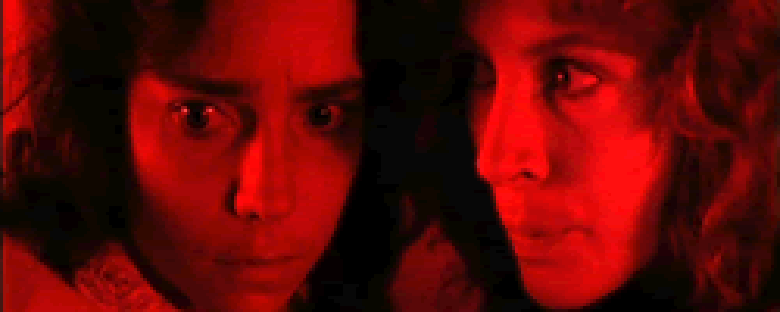Reviews
Dario Argento
Italy, 1977
Credits
Review by Rumsey Taylor
Posted on 11 July 2004
Source Anchor Bay Entertainment DVD
Horror has predominated in film because it is a cheap, commercially viable and popular genre. If one views its breadth based only upon American efforts, it seems that a horror film is incomplete minus some iconic figure of horror: a Freddy, Jason, or the ghost-faced killer from Scream.
The American film industry has long since been aimed at commercial gain, as popular themes, formulas, actors, and, in this case, monsters are frequently reused. There is little integrity in contemporary American filmmaking, and even less so in American horror films, hence numerous sequels to Nightmare On Elm Street and Friday The 13th.
In other countries such filmic conventions are absent in the horror genre. Unrecognized casts are common, as are completely exploitative, seemingly audience-unfriendly themes (i.e., Nekromantik, which has been repeatedly banned across the globe). Jess Franco’s Vampyros Lesbos echoes the spirit of Sixties sexuality by displaying a primary female character with a growing curiosity for lesbianism. Her curiosity is manifested in the form of, obviously, vampirism. You will not find it at Blockbuster.
Foreign horror with its welcome disregard to convention is in turn cherished for its innovation. In terms of technical prowess the king of horror cinema is Italy’s Dario Argento. His masterpiece is the lurid Suspiria, which boasts the most arresting tagline for any horror film.
Typical horror employs what is referred to as a buffer. It is used immediately following a scene of intense horror (discerned by the clichéd yet permanently frightening “scare chord”) and is distinguished by either a long static shot, silence, or in most cases both. Suspiria arguably contains one such buffer in the form of the end credits. Imagine over ninety minutes of mounting discomfort.
The title is some sort of nominalization that bears enough resemblance to an actual word (to suspire is to draw a long, deep breath) that its nonsensical function is mistaken. Suspiria is the first of a presupposed trilogy and justifies its lack of narrative establishment with its fresh approach to familiar material. Inferno is the only sequel, and the third installment was never conceived.
The first death scene has such an unexpected, panicked intensity that the victim’s initial curiosity and resulting terror are exchanged directly to viewers. In summary, a woman is stabbed, dropped through a skylight and hung as resulting glass shrapnel claims a second. What happens is not as important as how it is depicted in lighting, framing, manic editing, and score. Every filmic element functions to enhance the atmospheric dread; not, however, to compliment the scene. The result is one of the most technically impressive death scenes in film.
Suzy Banyon is the film’s protagonist, played with wide-eyed naïveté by American newcomer Jessica Harper. Suzy is in Germany beginning to attend a premiere European dance academy. In a manner similar to fairy tales (Argento has admitted Snow White as a primary influence) Susie enters a world unknown and attempts to escape only after she is seemingly trapped. This brief narrative functions as expository relief. Suspiria is in synopsis a series of distantly related yet effective scenes of horror.
Suspiria loses something in its otherwise commendable diversion from conventional horror expectations. The film may indeed be scary when seen for the first time. However, in subsequent viewings the film’s intended scares are lost, and one’s appreciation for its technique is heightened. Argento is apparently more taken with the craft of his direction than with his film’s narrative content, yet the film is such an accomplished display of technical ambition that Suspiria’s horror is laudable.
Goblin’s score lends a tremendous compliment to the film. In their main theme for the film, entitled “Daemonia,” utterances of the word “witch” are curiously heard — this is unsuccessfully intended to be subtle reference to the film’s primary enemy.
The film was shot without sound and was in turn dubbed in several languages. Harper has said to have spoken English during shooting to the Italian responses of her co-actors. Watching the English version notices are made of how only Suzy’s voice coherently matches her screen image. The rest of the cast’s voices are laughably mismatched. In a futile effort to justify this technique, it could be argued that it adds to the primary character’s feelings of alienation.
Like any good horror film Suspiria has had its brush with controversy. Since its release it has been trimmed according to various distributor standards. Of particular objection is a scene in which a blind man is martyred by a seeing-eye dog. The scene would have been hugely distasteful had it not been captured with exacting attention to artistic construction. In effect the scene dodges its obvious camp value.
It can be mentioned that the dance academy is revealed to be a witch’s coven. Though this detail is treated as an important plot point its revelation in the film is both anticlimactic and expected. Plot details such as this take a second hand to the Suspiria’s discomforting atmosphere.
A witch thus becomes the film’s iconic monster and yet there is no demonic giggle, no broom and no boiling cauldron. The film is only about a witch to appease a horror standard, in that monsters are frequently subjects of horror movies. In essence it is not about a witch and her coven but rather the fundamental makeup of horror; what scares people is not the image of a monster but rather the sustained uneasiness that precedes it. Argento preys on this paranoia in the entirety of his film. His monster is so drearily anticipated that when it is revealed in the closing minutes its clichéd function is forgiven.
We don’t do comments anymore, but you may contact us here or find us on Twitter or Facebook.



